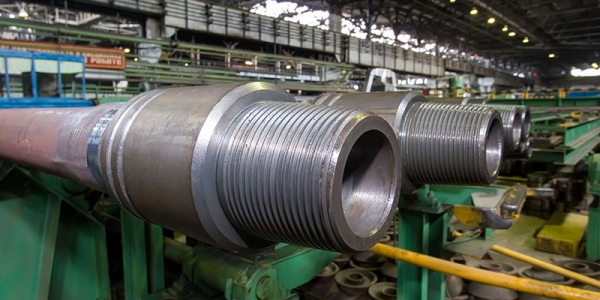Drill pipes are an essential component in the oil and gas industry, used to transfer drilling fluid and apply rotational force to the drill bit during drilling operations. The manufacturing process for drill pipes involves several steps to ensure their durability and functionality under harsh drilling conditions. Here's an overview of the typical drill pipe manufacturing process:
Selection of Raw Materials:
Drill pipes are commonly made from high-strength alloy steel to withstand the stresses and pressures encountered during drilling. Commonly used materials include AISI 4145H and AISI 4140. These materials offer excellent mechanical properties, such as high tensile strength and impact resistance.
Cutting and Forming:
The first step involves cutting the raw material into appropriate lengths, which are usually around 30 feet (9 meters). These lengths are then heated to a specific temperature to make them malleable for further processing. The heated lengths are formed into tubes using a combination of mechanical processes like hot rolling or extrusion.
Heat Treatment:
Heat treatment is a critical step to enhance the mechanical properties of the drill pipes. The tubes are heated to a specific temperature and then rapidly quenched to achieve the desired hardness and toughness. This process also relieves any residual stresses introduced during forming.
Threading and Upsetting:
The ends of the drill pipe are threaded to connect with other components of the drill string, such as the drill bit and the bottom hole assembly. The threading process involves cutting the threads onto the pipe ends using specialized threading machines. After threading, the ends are usually upset (swelled) to increase their wall thickness, making them more robust and able to handle the stress of drilling operations.
Inspection and Testing:
Each step of the manufacturing process involves rigorous quality control and inspection. This includes ultrasonic testing, magnetic particle inspection, and other non-destructive testing methods to detect any defects or irregularities that could compromise the integrity of the drill pipe.
Hardbanding:
Drill pipes are susceptible to wear, especially near the tool joints where they make contact with the wellbore. To mitigate wear and extend the life of the drill pipe, a hardbanding process is often applied. This involves welding wear-resistant materials onto specific areas of the pipe.
Coating and Protection:
Drill pipes are often coated with a layer of phosphate coating or an anti-corrosion coating to protect them from the harsh drilling environment. This helps prevent rust and corrosion, which can weaken the pipe over time.
Final Inspection and Certification:
Before being sent to the field, the drill pipes undergo a final inspection to ensure they meet the required specifications and standards. Once they pass inspection, they are certified for use in drilling operations.

It's important to note that the manufacturing process might vary slightly depending on the manufacturer, the specific design requirements, and the intended drilling conditions. The goal of the process is to create drill pipes that are durable, reliable, and able to withstand the challenging conditions of drilling operations. Fore more information, you can check the link: Application Of Drill Pipe And Drill Collar

 English
English Español
Español




 Tel : +86-18565811709
Tel : +86-18565811709 Email :
Email : 

 News
News




